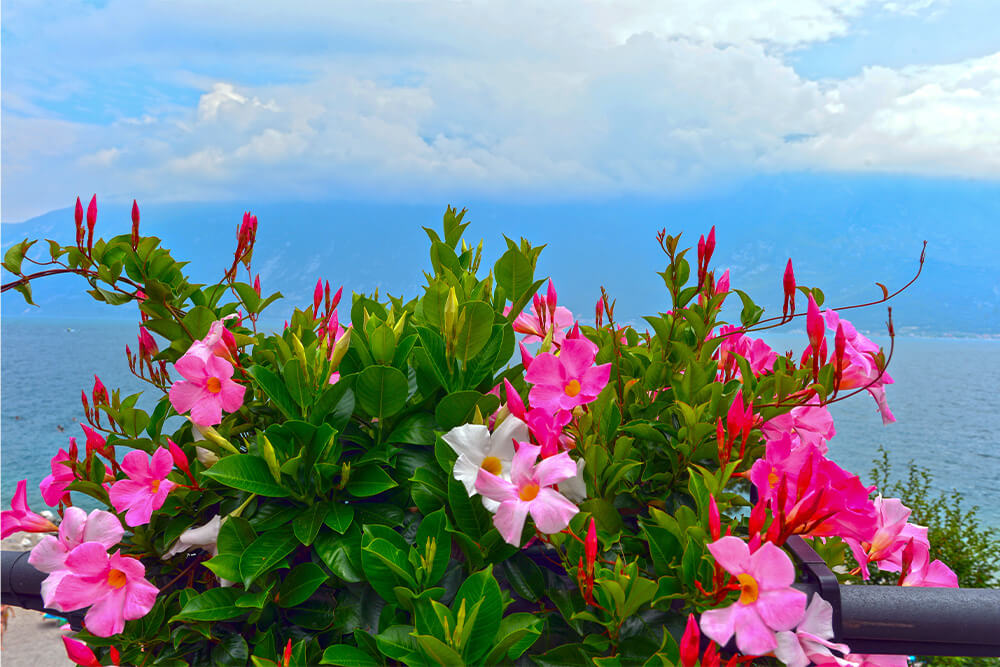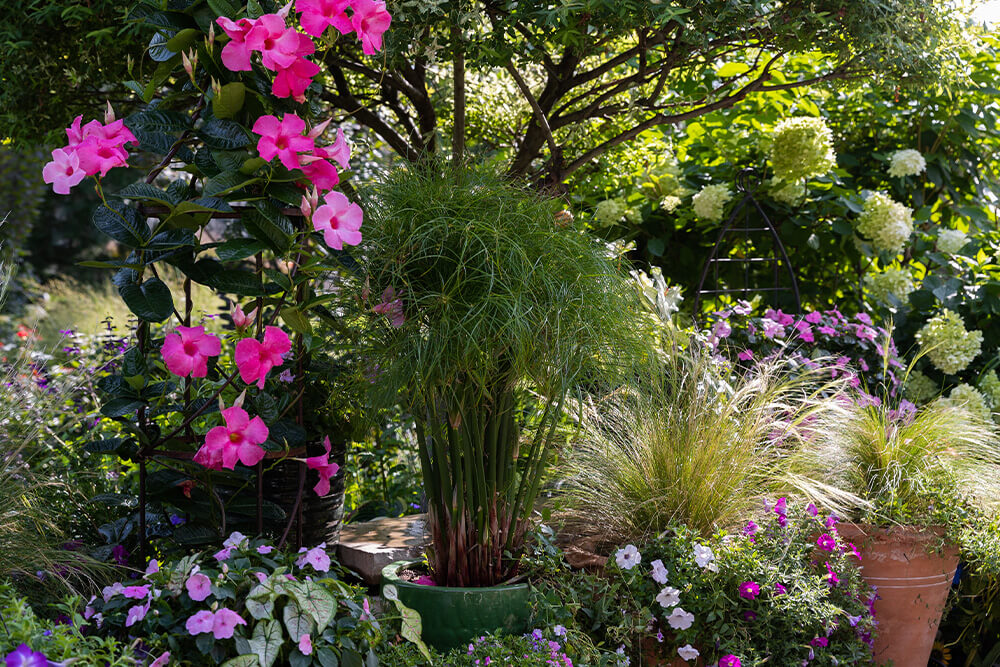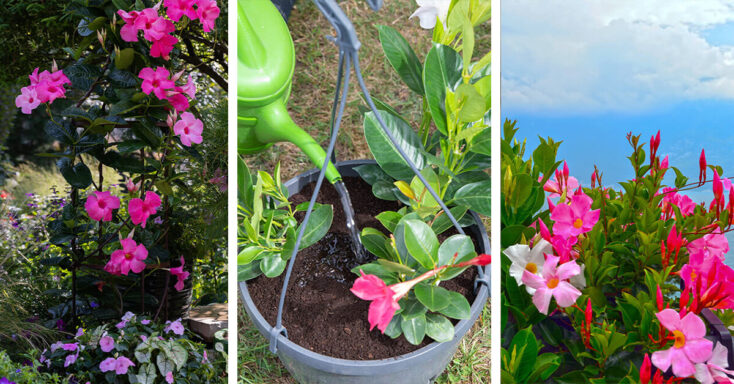Mandevilla care is possible indoors or out, so people who don’t have the right outdoor environment can still enjoy them. These flowers have a tropical feel and bursting colors. You can also use them to fill vertical space.
Key Takeaways
- Mandevilla (rocktrumpet) is a flowering vine, giving it reach (literally) in terms of how you use it in your garden
- The flowers from rocktrumpets bear a light, pleasant aroma
- If you live in a warmer region, Mandevilla can blossom year-round
- Mandevilla species have symmetry. If a plant has large blossoms, there aren’t as many. Those with smaller blossoms have more plentiful shows.
Mandevilla Vines vs. Mounds
Mandevilla has two basic categories: vines and mounds. The vine version is familiar to gardeners because it brings color and levels to a small garden. Mandevilla vines wrap their new growth around the support you provide. This plant tells you in which direction it wants to grow. If yours is a counterclockwise plant and you try to train it clockwise, the plant won’t accept the trellis, pole, etc. Vining Mandevilles can reach up to 15 feet tall. TIP: you can train them horizontally, too.
As the name implies, mounding mandevilla forms tidy mounds. They adjust to container planting and make excellent bed and border plants for your landscape. They are far smaller than their vining companion, reaching only 18 inches tall. You can use them in window boxes or hanging features around your yard.
Color My World: The vast majority of Mandevillas were originally pink. Over time, plant cultivators expanded the plant’s color palette. It now includes pastel pink, pure white, apricot, and red.
Outdoor Mandevilla Care
If you sometimes forget to water, you’ll enjoy the fact that mandevilla is drought-tolerant. You’ll want to put them in an area of your yard where they can get at least 6 hours of full sun daily. If they start looking lanky, the flower is not getting enough daylight.
Check that the location drains well. If you’re using mandevilla in a container, fill it with potting mix, not garden soil. Ground-planted mandevillas don’t usually require fertilizing, but potted plants do. The fertilizer supports profuse blossoms. Look to time-release formulas for consistency.
If you live in an area with regular frosts, you can winter the mandevilla indoors for winter.
Mandevilla is a common Mother’s Day gift because it represents resilience, attentiveness, and nurturing. In the Victorian language of flowers, they express attractiveness, gentility, and sensitivity. If presented to a romantic interest, mandevilla means affection, determination, and devotion. In floral arrangements, mandevilla is an emblem of elegance and beauty. Spiritually speaking, mandevilla is the flower of spiritual growth and graceful transformation.
Mandevilla Needs in Your Landscape
Think of these plants as sun worshipers. The full-day sun brings out the mandevilla’s beauty. Avoid areas with less than filtered light. Without the right lighting, your plant won’t produce new buds.
When you think about your yard, make sure you give mandevillas plenty of room to grow. Your plant grows in equal proportions: plant height equals the size of root growth. In other words, if your flower doesn’t have enough room, it will cease to grow.

Have you ever gone away for a few days and found your houseplants dead when you returned? You don’t have to sweat it with mandevilla. This plant prefers a weekly watering, provided it hasn’t rained. If you hit a hot spell, water every other day. By the way, whether you plant mandevilla in the ground or pots, it requires good drainage. Check your containers for drainage holes.
Should your mandevilla develop yellow leaves, it’s waterlogged. Drain it out completely, get it into the sun, and hold off on more moisture until you see the plant perk up again.
Mandevilla Memoirs: Mandevilla, as a flowering vine, was introduced as a genus in 1840. The common name is rocktrumpet. They are native to Mexico, Central America, the Southwestern US, and the West Indies. Some feel the plant may have come from Brazil. It’s named after a British diplomat and gardener, Henry Mandeville.
Shopping for Mandevilla
As you look through the Mandevilla at the local nursery, avoid any plants with yellow leaves, as it indicates plant stress. Just because one is flowering doesn’t mean it’s necessarily healthy. On the upside, you can see the exact color before buying.
If any roots are peaking out below the container, white creamy ones are hardy. Mushy brown roots are sick and potentially rotting. They smell bad, too.
Make sure you get the type desired (vining, mounds).
Popular Mandevilla Types
- Agate: An early-blooming plant with large flowers. Adult height 20 feet. Blossoms from spring to late autumn. Weather resistant.
- Alice Dupont: One of the very first varieties of mandevillas available to gardeners. Awarded the Royal Garden Society’s “Garden Merit.” A vining type with ice-pink outer petals and deeper pink within. Wrinkled, bright green leaves. At most, 15 feet at maturity.
- Jade: a mound mandevilla that grows 3-4 feet tall. It has an exotic feel and comes in white, pink, or red.
- Opal Yellow: Vine-like but short (2 feet). Bold yellow flowers set in a forest of deep green. The “Opal” series also comes in red and pink.
- Sanderi: A vining rocktrumpet, growing up to 10 feet. The large flowers come in red, white, or pink.
- Stars and Stripes: A bushy variety, striped with white and red. Average size, 12 inches tall with a 24-inch spread.” Some Stars and Stripes look peach orange.
- Summer Romance: This plant yields double pink flowers up to 4 inches long. Blossoms from spring to near frost. 18-36 inches tall.
- Summervillea: A mounding variety dotted with rich red flowers—smooth, shiny dark green leaves. It comes in several other colors, including old-school pink.
- Sun Parasol: This Mandevilla hybrid comes in a wide range of colors, including deep velvet red. Average size 20-15 feet with a 2-3 foot spread.
- White: Another vining mandevilla that grows 15 feet. While it is called white, the flowers present with yellow throats.
- Variegated: When you’re looking for variegated foliage, there are several selections of mandevillas from which to choose. Examples include Fire and Ice Fury, Amabilis – pink and yellow, and Snow Queen – green and white.
The two-tone Apricot blooms are relatively new in the mandevilla family tree. It’s open-faced with pink-orange on the outer portion and a vivid orange center. Apricot came about at a time when you could only find this flower in red, pink, and white. The summerstar series has also come onto the market. It has heavily saturated blossoms with intensely colored flowers.
Watering Mandevilla
Mandevilla thrives with consistent moisture. When the plant has curling or drooping leaves, it needs watering. Give them water right away and watch for improvements. You may lose some flowers as a result.

When first planted, the mandevilla needs more water for root development. When the top layer starts to dry out (damp), give them water. After they’re established, think “moist” vs. “wet.” Container-grown mandevilla needs water daily.
Water these plants first thing in the morning, applying water at the base of the plant. This gives the roots time to absorb it before the noon heat arrives.
Ongoing Awards: Members of the Mandevilla family have garnered the attention of gardeners everywhere. In particular, the Royal Horticulture Society has the Award of Garden Merit. In order to qualify, a plant must illustrate excellency in suitable conditions, availability, having a good constitution, stable colors, and some residency to diseases and pests. Two mandevillas that received this recognition are the Sundaville Cream Pink and Allice du Point.
Approaches for Potting and Repotting Outdoor Mandevilla
When you get your plant at the nursery, buy a suitable pot with drainage holes. These plants are susceptible to root rot. Fill the container with lightweight potting soil about ⅓ way up (to the point where you can put the plant at the same depth as it is in the current plastic carrier). Lay the container on its side and wiggle the mandevilla gently. You may need to tug softly at the base of the plant while loosening the pot.
At this time, if you notice any damaged or dead ones, trim them. Move the plant to the crock you’ve prepared. Finish backfilling the soil, giving it a slight pat to support the plant.
Your mandevilla needs repotting about every two years. Choose a new container one size up from what you’re currently using. Wait to make the change until early spring. Follow the same procedure as you did when you brought the plant home.
One trick. If you’ve trained your mandevilla on a trellis, you may need help lifting the root ball out and transferring it into the new container. Try to avoid pulling on the vine.
Fertilize them during the growing season. Apply slow release every two weeks.
Because Mandevilla can grow horizontally and vertically, you can use it for ground cover. The foliage is dense, and the little flowers are charming. Check your cultivar to see how long your plant grows by maturity. This will help you plan the distance between the Mandevilla planted. There is no reason you cannot mix colors along the way. Mind you, unless you live in USDA zone 9-10, mandevilla ground cover will be a fast-growing annual.
Mandevilla: Pruning and Maintenance
Mandevilla pruning should take place during late winter or early spring. If you see signs of new growth, hold off. The fast nature of mandevilla growth means that it puts out flowers and shoots in rapid sequence. You can, however, trim back dead pieces and old growth that seem to be getting leggy. The cleanup gives the plant a compact, tidy appearance.
Never prune new growth intensely, as it deters flowers. When flowers die, you can pinch them off. This plant blooms all season long, but when you deadhead, you may find it flowers more profusely. More importantly, keeping your mandevilla clean helps prevent certain fungi and insects.
Always use clean pruning equipment for maintenance. Never remove more than ⅓ of the total mass.
From the Vine:Vining Mandevilla makes visually interesting additions to your landscape. Train them to walls, trellises, and other supports. Put one that grows clockwise and another that grows another next to each other. You can choose two different colors for a conversation piece. You might also consider hanging basket displays.
Mandevilla Blooming and Resting Periods

In areas receiving frost, Mandevilla must winter indoors. Mounding and potted plants are the obvious choices. Vining plants may have to be renewed the next season. If you bring your plants indoors, just trim them to a manageable size. Put them where it will get bright light and continue watering as normal.
You probably won’t see any blossoms in winter. The plant needs to store energy. It may also drop some leaves. When you see spring growth, you can move your plants back outdoors.
Some plants make suitable companions for mandevillas. These include coleus, dipladenia, lantana, and tropical hibiscus. These four plants have the same hardiness zones. They also have similar needs in terms of environmental conditions. When sown near mandevillas, they have the ability to give your plant some weather protection.
Common Pests and Plant Diseases
For the most part, Mandevilla are tough cookies. But even the strongest plant can still incur pests or diseases. With both, the sooner you catch the problem, the better your chances of remediation.
Each time you water your plants, take a quick look at them. In particular, inspect the underside of leaves. Mealybugs leave waxy debris on the branch connections and feed on the leaves nearby. As they feed, they also leave behind a sticky substance called honeydew. Insecticidal soap is a good option.
Scale is a sneaky insect who knows how to hide. They actually look like waxy deposits on both stems and foliage. Regular applications of Neem should help. When you see the scale changing colors, continue treatment, but you are on the way to success.
Spider mites are difficult to see. What you can recognize is the damage they create. Leaves appear with yellow dots. The leaf starts to dry and falls off. Spider mites leave behind little webs. You can actually knock these critters off with a hose, but if that doesn’t work, use Neem.
In the disease column, we find Anthracnose. Symptoms include leaf spots and plant dieback. The foliage develops tan-brown spots near the veins. Sometimes, this looks like a fungal disease. Your best management is removing any infected part of the plant and treating it with a broad fungicide.
If you see grey or white powdery spots on your plant, that’s Powdery Mildew. The spots spread, eventually covering most of the foliage. Making sure your plant has proper airflow and sunlight helps greatly. You can also spray your mandevilla with a mixture of baking soda, Castile soap, and water.
Mandevilla Topiary: You can use mandevilla vines to create ornamental topiary in your landscape. Rather than regular support, use chicken wire or something similar. Shape the wire into what you want it to look like when you’re done. Plant your vines, and help them attach as they grow.
Troubleshooting Common Mandevilla Problems
- Yellowing: Yellowing can reflect a lack of water. Your plant needs moist soil. You can use a wooden chopstick to test the dirt. Gently insert it into the soil and leave it for ten minutes. Remove. If it changes color, you have enough moisture. It is worth noting that as Mandevilla ages, they develop yellowing at the base of the plant, accompanied by leaf drop. If foliage starts dropping, then something else is amiss.
- Failure to Thrive: as tropical plants, mandevilla likes warmth, humidity, and sunshine. They won’t thrive when the weather gets too cold—these plants also lose flowers and leaves after a dramatic environmental change.
- Dying: Decolored leaves, wilting leaves, slowed growth, and surfacing roots are all possible signs of plant death. The main causes for this include under-watering or over-watering, lack of nutrients, too little light, and pest or disease issues.
Frequently Asked Questions About Mandevilla Care and Keeping
Does Mandevilla come back every year?
In frost-free environments, the answer is yes: Mandevilla is perennial. In colder climates, you’ll lose the plant to frost damage, making it an annual unless you winter it indoors.
How do you keep a Mandevilla over the winter?
If you have enough space with a bright, sunny window, just bring your mandevilla indoors and continue maintaining it as you did in the garden. Just prune it back by half, making it more suitable for indoor spaces. An indoor temperature of 65F is ideal.
How do you keep mandevilla blooming?
Make sure your plant receives at least 6 hours of exposure to sunlight daily. Feed the plant with a balanced fertilizer. Trim back any overgrowth.
How long does a mandevilla last?
With proper care, mandevilla plants last for several years.
Can potted mandevilla survive winter?
It depends on your location. If the temperature outside goes below 50F, it’s time to move your plant indoors. You can use the garage barring household space as a spot for letting them go dormant.
Summary
Mandevillas begin blossoming in spring, and many stretch long into fall. They come in all sizes with small or big flowers, plentiful buds, or fewer buds. Most cultivars have shiny ovate leaves, which make a stunning backdrop for the flowers. You can winter this plant indoors if you live in areas with fall freezes. Overall, this is a hardy plant you can care for easily.
Final Thoughts
It’s easy to fall in love with Mandevilla plants. They’re in the low to mid-low level of care compared to other garden plants. I like the fact that you can grow them as vines, bushes, or in containers. This gives me more flexibility when planning the landscape.


